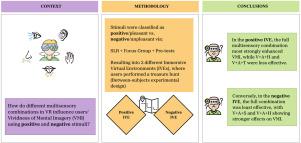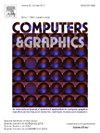虚拟现实中心理意象的生动性:虚拟旅游中的多感官体验研究
IF 2.8
4区 计算机科学
Q2 COMPUTER SCIENCE, SOFTWARE ENGINEERING
引用次数: 0
摘要
本文旨在评估在虚拟旅游背景下,多感官刺激的不同组合如何影响用户心理意象的生动性。为此,对94名参与者进行了一项受试者间实验研究,他们被分配到积极或消极的沉浸式虚拟环境中。积极环境只包含愉快的多感官刺激,而消极环境只包含不愉快的刺激。对于每一种虚拟体验,都开发了一种多感官寻宝游戏,其中发现的每个对象都对应于计划中的刺激组合(相应地是积极的或消极的)。结果表明,积极刺激涉及更多的感觉模式导致更高的报告生动度。相比之下,当同样的多感官模式与负面刺激一起传递时,生动程度下降——我们将这种效应归因于潜在的认知超载。然而,一些减少的负面组合(视听与嗅觉和视听与触觉)仍然有效,这表明嗅觉和触觉线索在塑造用户的心理意象的生动性方面起着重要作用,即使在负面环境中也是如此。本文章由计算机程序翻译,如有差异,请以英文原文为准。

The vividness of mental imagery in virtual reality: A study on multisensory experiences in virtual tourism
This paper aims to evaluate how different combinations of multisensory stimuli affect the vividness of users’ mental imagery in the context of virtual tourism. To this end, a between-subjects experimental study was conducted with 94 participants, who were allocated to either a positive or a negative immersive virtual environment. The positive environment contained only pleasant multisensory stimuli, whereas the negative contained only unpleasant stimuli. For each of the virtual experiences, a multisensory treasure hunt was developed, where each object found corresponded to a planned combination of stimuli (positive or negative, accordingly). The results showed that positive stimuli involving a higher number of sensory modalities resulted in higher reported vividness. In contrast, when the same multisensory modalities were delivered with negative stimuli, vividness levels decreased — an effect we attribute to potential cognitive overload. Nevertheless, some reduced negative combinations (audiovisual with smell and audiovisual with haptics) remained effective, indicating that olfactory and haptic cues play an important role in shaping users’ vividness of mental imagery, even in negative contexts.
求助全文
通过发布文献求助,成功后即可免费获取论文全文。
去求助
来源期刊

Computers & Graphics-Uk
工程技术-计算机:软件工程
CiteScore
5.30
自引率
12.00%
发文量
173
审稿时长
38 days
期刊介绍:
Computers & Graphics is dedicated to disseminate information on research and applications of computer graphics (CG) techniques. The journal encourages articles on:
1. Research and applications of interactive computer graphics. We are particularly interested in novel interaction techniques and applications of CG to problem domains.
2. State-of-the-art papers on late-breaking, cutting-edge research on CG.
3. Information on innovative uses of graphics principles and technologies.
4. Tutorial papers on both teaching CG principles and innovative uses of CG in education.
 求助内容:
求助内容: 应助结果提醒方式:
应助结果提醒方式:


